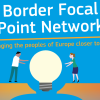I am from Friuli Venezia Giulia, a region nestled between Italy, Slovenia, and Austria. This region is considered a region at the edge of Italy, far away from the Italian economic and political centers such as Milan and Rome. However, I believe that Friuli Venezia Giulia’s cross-border feature should be its strength. It can bring together three different cultures, act as a door to Central Europe and Eastern Europe and, most importantly, strengthen the European identity.
A lot has already been done thanks to Friuli Venezia Giulia’s participation in several Interreg A programs, however, there are still persistent obstacles that keep Italian citizens mentally and physically further away from their cross-border counterparts. A crucial one is the mental barrier between the citizens related to language and the lack of common activities (Medeiros, 2018). Cooperation should be further enhanced to make citizens feel closer. Education and local development are key to achieving this.
Overcoming mental barriers should start from a young age. Efforts should be made already at school and university so that the border is not felt strongly. For example, I attended high school close to the Slovenian border, but there was no exchange with Slovenian students. Slovenian and Italian students should not necessarily be expected to teach each other their language, but they could still be involved in joint school projects, such as trips, perhaps using English as a common language of communication. Such activities could even be organized as rewards for English language competitions, to incentivise students to learn this common language.
A similar situation happened in relation to Austria: although I studied German at school, I did not have any contact with Austrian students. Schools should be incentivised and helped by Interreg programs to apply for European funds that can foster cooperation. This lack of cooperation continued throughout my university studies. I studied in the city of Gorizia (the next capital of Culture with the cross-border city of Nova Gorica) but there wasn’t much contact with the University of Nova Gorica. It was a missed opportunity as I think that there could have been common seminars taught in English to bring students and professors closer. However, I hope that the Capital of Culture 2025 Gorizia-Nova Gorica, also funded by Interreg Italy-Slovenia, will boost the cooperation between the cities, hopefully including schools and universities as much as possible.
Moreover, Gorizia-Nova Gorica 2025 introduces the other key to bringing citizens closer: local development. In this regard, the municipalities and the EGTC could become a good example of development strategies to involve local citizens. Municipalities should be helped as much as possible to animate the territory and organize activities for cross-border citizens. Another initiative focused on local development is the Community-Led Local Development of Interreg Italy-Austria. In my region, the HEurOpen strategy involves actors from 52 cross-border municipalities that fund medium and small projects for cross-border local development (HEurOpen - LEADER-Kooperation Hermagor, Euroleader & Open Leader, n.d.).
Bibliography
HEurOpen—LEADER-Kooperation Hermagor, Euroleader & Open Leader. (n.d.). HEurOpen. Retrieved May 17, 2024, from https://heuropen.eu/
Medeiros, E. (Ed.). (2018). European Territorial Cooperation: Theoretical and Empirical Approaches to the Process and Impacts of Cross-Border and Transnational Cooperation in Europe (1st ed. 2018). Springer International Publishing : Imprint: Springer. https://doi.org/10.1007/978-3-319-74887-0
- Влезте в системата, за да можете да публикувате коментари.

